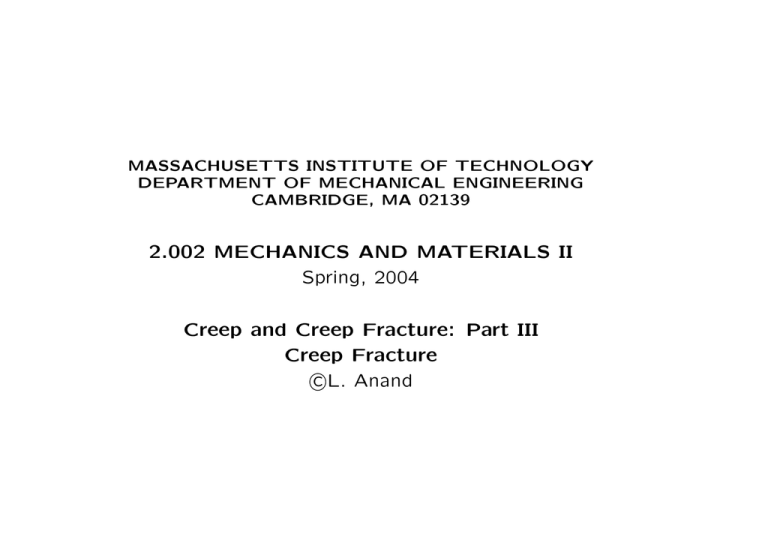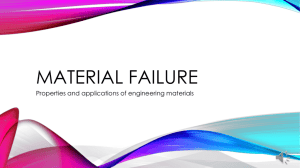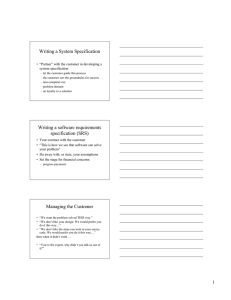Document 13664839
advertisement

MASSACHUSETTS INSTITUTE OF TECHNOLOGY DEPARTMENT OF MECHANICAL ENGINEERING CAMBRIDGE, MA 02139 2.002 MECHANICS AND MATERIALS II Spring, 2004 Creep and Creep Fracture: Part III Creep Fracture c L. Anand � Mechanisms of Creep Fracture Figure 1: Creep strain-time curve for constant stress at constant temperature Image removed due to copyright considerations. Figure 2: The upper row refers to low temperatures (≤ 0.3 TM ) where plastic flow does not depend strongly on temperature or time; the lower row refers to the temperature range (≥ 0.3 TM )in which materials creep. Figure 3: Schematic of creep fracture mechanisms Figure 4: Schematic of uniaxial stress versus time to fracture data Image removed due to copyright considerations. Figure 5: Map of isothermal fracture data for Nimonic-80A Image removed due to copyright considerations. Figure 6: Map of isothermal fracture data for 304 stainless steel Image removed due to copyright considerations. Figure 7: Map of isothermal fracture data for 316 stainless steel Image removed due to copyright considerations. Figure 8: Micrographs of copper plates illustrating the continuous distribution of creep damage in plates containing notches and subjected to far-field uniaxial tension. Note that it is predominantly the grain boundaries perpendicular to the applied stress that are preferentially damaged. Creep Fracture 1. Creep Rupture Diagram ˜ (1/ν)logtf logσ = log C− ˜ C C 1/ν = ⇒ tf = ν tf σ σ • Times to failure are normally presented as creep rupture diagrams. Their application is obvious. If you know the stress and temperature you can read off the life; for a given design life at a certain temperature, you can read off the stress. 2. Monkman-Grant tf = C σν σ = s ⎛ 1/n c ˙ ss ˙ 0 ⎞ ν s ν/n = ⎝ ν/n ⎠ ˙ ss ˙ 0 ν = C ˜ (Monkman and Grant) tf (˙css)˜ σν ˜ ≈ 0.1 ⇒ the creep strain to • Typically, ˜ ν ≈ 1 and C fracture ≈ 10 % 3. Time-Temperature Equivalence • Data is given in terms of σ in psi, tf in hours and T in degrees Rankine (460 +0 F ). Example Problem on Creep • A support beam made of 18Cr − 8N i stainless steel is to be used in a chemical reaction chamber operating at 6000C. The beam geometry and loading are idealized as shown below. • The performance requirements are that 1. The beam is to carry a constant load F = 600 N . 2. No macro-crack formation due to creep fracture in 25 years. 3. Tip-deflection not to exceed 4 cm in 25 years. • Determine if the beam meets the performance specifications. If either of the failure criteria are not met, then what is the maximum value of F that the beam can carry and not fail? Data for 304 Stainless Steel ˙ css = Bσ n; B = 1.095 × 10−18, n = 4.5 |σ| ⇒ ˙ = ˙ 0 s n ; ˙ 0 = 1 × 10−9sec−1, s = 98M P a, n = 4.5 Image removed due to copyright considerations. "Master Rupture Curve for 18-8 Stainless Steel." Solution: M (x) = −F (L − x) 0≤x≤L M (x) 1/n |y| σ(x, y) = − sgn(y) In In = A |y|1+1/n dA (1) For a rectangular beam n h 1/n 2 In = bh 2+ 4n 2 n ∂ 2v̇ |M | = ˙ 0 sgn(M ) 2 ∂x sIn (2) ∂ v˙ = 0 at x = 0 BCs: v˙ = 0 at x = 0, and ∂x |F | sIn n (L − x)n+2 Ln+2 1 + Ln+1x − n+1 n+2 n+2 n |F | Ln+2 δ̇ = |v̇(x = L)| = ˙ 0 (3) sIn n+2 v̇ = −˙ 0 Check for Macro-crack Formation From (1) and (2) M (x) 2y 1/n sgn(y) 2 σ(x, y) = − n 2+4n bh h Since M (x) = −F (L − x), maximum moment is at x = 0, i.e., Mmax = −F L, and maximum tensile stress occurs at y = h/2, we get σmax = FL n bh2 2+4n = 600 N × 1 m 4.5 2 3 2+4×4.5 × 0.02 × 0.04 m σmax = 83.33 M P a, and since 1 M P a = 145 psi, we get σmax = 12, 083 psi. The temperature is 6000C = 11120F = 15720R From Larson-Miller master curve for 18-8 stainless steel, logσ = logp − qθ p and q are constants Solve for q: log(σa/σb) q= ; logp = logσa + qθa θb − θa For σa = 10, 000 psi , θa = 41, 000; for σb = 2, 000 psi , θb = 50, 000 −5 Therefore, q = log(5) = 7.77 × 10 9000 Solve for p: logp = log10, 000 + (7.77 × 10−5) ∗ 41, 000 = 7.1842 ⇒ p = 1.53 × 107 Now, with θLM = T (20 + log(tf )), logσ = logp − qT (20 + logtf ) ⇒ log 1/(qT ) p σ = log(1020tf ) or tf = 10−20(p/σ)1/(qT ) where tf is the rupture time in hours, T is the temperature in degrees Rankine and σ is the stress in psi. tf = 10−20 1.53 × 107 1 7.77×10−5 ×1572 12, 083 8.187 −20 3 = 10 1.2662 × 10 = 2.513 × 105 hours Since 1 year = 365 × 24 = 8760 hours, tf = 28.69 years Therefore, a macro-crack will form on the tensile side of the beam after approximately 28 years. The beam is ∼safe for 25 years. Check for Deflection |F | δ̇ = ˙ 0 sIn n Ln+2 n+2 1/n h n bh2 In = 2 + 4n For b = 0.02 m, h = 0.04 m, n 10−6 m[3+(1/4.5)], F = 600 N , ˙ 0 98 × 106 N/m2 δ̇ = ⎧ 10−9 ⎨ 2 = 4.5, In = 3.0184 × = 10−9 sec−1, and s = 600N ⎫4.5 ⎧ ⎫ ⎬ ⎨ (1m)[2+4.5] ⎬ sec ⎩ (98 × 106 N2 ) (3.0184 × 10−6m[3+(1/4.5)]) ⎭ m ⎩ δ̇ = 3.7 × 10−9 m/s ⇒ δ = (3.7 × 10−9m/s) × t t = 25 years = 25y × 365da/y × 24h/da × 3600sec/h = 7.884 × 108 sec 6.5 ⎭ Therefore, δ = (3.7 × 10−9)m/s × (7.884 × 108)s = 2.951 m Too much deflection! A deflection of 4 cm would occur after only 0.04m 7 sec = 3000 hours t= = 1.08 × 10 3.7 × 10−9m/s The load has to be decreased substantially. For a total deflection of 4 × 10−2 m in 25 years 4 × 10−2m δ̇ = = 5.0 × 10−11 m/s 25y × 365da/y × 24h/da × 3600s/h From ⎡ ⎤1/n ˙ ˙ 0) ⎥ ⎢ (δ/ ⎥ ⎢ ⎦ F = ⎣ Ln+2 n+2 sIn = 231 N = 52 lbf Alternatively, the ratio of the deflections is the ratio of the deflection rates, which in turn are proportional to the load ratio, raised to the power n = 4.5; |F | 600 N ⇒ |F | = 600 N × 4.5 .04 2.951 = 1 4.5 .04m/25y 2.951m/25y = 600 N ×(.01355).2222 = 231 N.








